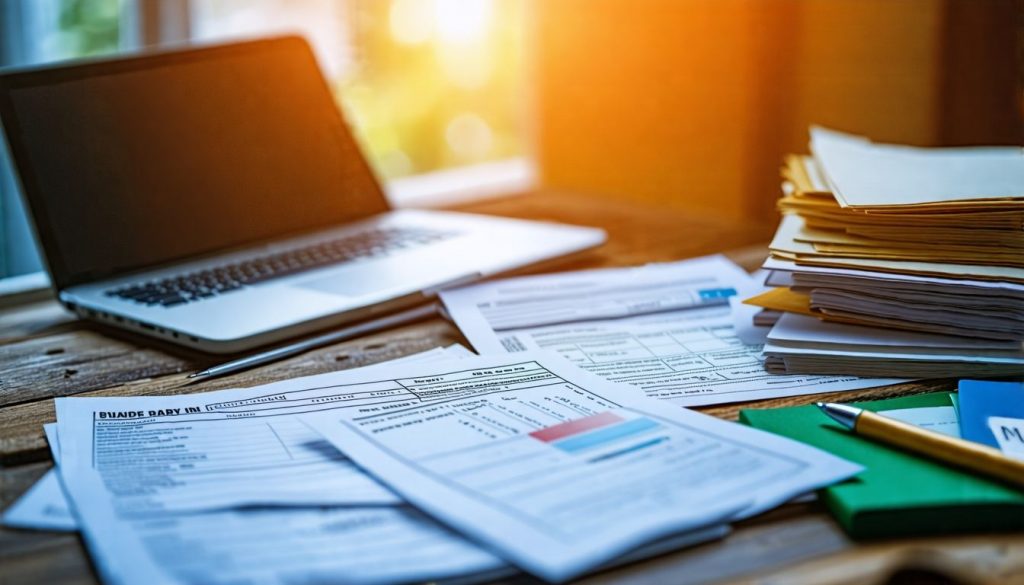Dealing with unpaid debts can be a significant challenge for small business owners. A startling fact is that many businesses struggle with recovering written-off debts, impacting their financial health.
This article offers insights into bad debt recovery, providing strategies and solutions designed to guide small business owners through this complex process. Discover how to turn financial setbacks into recoveries—read on.
Key Takeaways
- Small business owners can fight bad debts by knowing why they happen and choosing smart collection methods. This includes making payment plans, using collection agencies, or even going to court if needed.
- Keeping your accounting books updated is crucial after collecting any bad debts. This helps show the real financial picture of your business and ensures you make informed decisions.
- Bad debt recovery also involves understanding tax rules. When a business writes off a debt as uncollectible, it might lower their taxes. Yet, if that money is later collected, it must be added to income on the next tax return.
- Protecting against future bad debts is possible by using strategies like getting insurance for bad debts and sending clear letters asking for payment from customers who owe money.
- Continuously improving knowledge on handling accounts receivable and staying current with tax law changes can boost a small business’s ability to manage and recover from bad debt situations effectively.
What is Bad Debt and How Does it Occur?
Bad debt refers to money owed to a business that is unlikely to be paid. This situation often arises when customers fail to fulfill their payment obligations due to financial difficulties or other issues.
Definition of bad debt
Bad debt refers to amounts owed by customers that are unlikely to be recovered. This situation typically arises when clients experience financial difficulties, fail to pay their invoices on time, or simply refuse to honor their debts.
For small business owners in Canada, understanding bad debt is crucial for effective credit management and maintaining healthy cash flow.
Recognizing bad debt early can help businesses implement appropriate debt recovery strategies. These strategies may involve revising accounting books and making necessary tax return adjustments.
Small companies equipped with knowledge about debt recovery options will find themselves better prepared to tackle the challenges of recovering written-off debts efficiently.
A proactive approach towards managing bad debts can significantly enhance a small business’s financial health.
Reasons for bad debt
Bad debt arises due to various factors that can affect the cash flow of small businesses. Understanding these reasons helps owners take proactive measures in managing their finances.
- Customer Defaults: Some customers might fail to pay their bills on time or at all, leading to unpaid invoices. This situation often occurs with new clients or those experiencing financial struggles.
- Economic Downturns: Economic slowdowns can result in decreased consumer spending, impacting a business’s income. During tough times, many individuals and companies prioritize essential expenses and may disregard payments owed.
- Poor Credit Management: Lacking proper credit assessment processes can lead to extending credit to unqualified customers. Without evaluating a customer’s creditworthiness, businesses risk delaying payments or not receiving them altogether.
- Inadequate Documentation: Failing to keep clear records of transactions can create confusion over payment terms and amounts owed. Miscommunication often leads to disputes over debts that could have been avoided with better documentation practices.
- Unclear Payment Terms: Setting vague payment terms can cause misunderstandings about when payments are due. If clients do not clearly understand their obligations, they may miss deadlines, resulting in bad debt situations.
- Market Competition: Intense competition can push businesses into offering favorable credit terms that may not be sustainable long-term. While enticing clients with easy repayment options might initially boost sales, it increases the risk of bad debt if customers cannot keep up with the payments.
- Insufficient Follow-Up: Not following up on overdue accounts promptly can lead to higher levels of uncollectible debt. Regular reminders and effective communication are key components in ensuring timely payments from clients.
- Bankruptcy Filings: Clients declaring bankruptcy will likely leave unpaid debts behind for creditors to recover as best as they can. Businesses must prepare for the possibility of losing some money permanently when faced with client bankruptcies.
- Changing Consumer Preferences: Rapid shifts in consumer demand may leave some businesses unable to collect on outstanding debts as customers transition away from products or services offered previously.
- Fraudulent Activity: In rare cases, businesses might encounter deceitful individuals who intend never to pay for goods or services provided intentionally misleading information during transactions.
Understanding these causes forms a foundation for protecting against potential bad debts in financial management strategies for small business owners across Canada.
Dealing with Bad Debt
Bad debt can significantly impact a small business’s financial health. It is crucial to track these debts accurately and plan effectively for recovery options.
Accounting for bad debt
Accounting for bad debt is crucial for small businesses. Recognizing and recording bad debts helps you maintain accurate financial statements. You should identify accounts that are unlikely to be collected and write them off as uncollectible.
This process involves adjusting your accounting records to reflect the loss, which can impact your overall financial health.
Properly accounting for these debts also ensures compliance with tax regulations in Canada. When you write off a bad debt, it may be possible to claim a deduction on your tax return, reducing your taxable income.
Understanding how these deductions work can significantly aid in managing small business finance effectively. Next, explore the various options available within the bad debt recovery process.
Provision for bad debt
Provision for bad debt is a crucial aspect of financial management for small businesses. It involves setting aside a certain amount of money to account for debts that may not be collected in the future.
This practice helps manage risk and ensures accurate financial reporting. By recognizing potential losses early, business owners can better assess their credit risk and maintain healthier cash flow.
Establishing a provision also impacts tax implications. Small business owners should understand how these provisions affect taxable income, as they can often create deductions that lower overall tax liabilities.
Keeping track of such provisions enhances transparency in financial statements and supports informed decision-making regarding debt recovery strategies.
Tax implications
Tax implications of bad debt recovery can significantly impact small business owners. In Canada, businesses that recognize a debt as uncollectible may write it off for tax purposes.
This process allows them to reduce their taxable income, providing some relief from the financial strain caused by unpaid debts. However, once a bad debt is recovered, the amount collected must be reported as income on the next tax return.
This ensures that any previously written-off amounts are accounted for correctly.
Understanding these fiscal responsibilities is crucial for maintaining accurate financial records and compliance with Canadian tax laws. Utilizing debt recovery services or agencies can assist in navigating this process efficiently and ensuring all necessary adjustments are made promptly in your accounting books.
The following section will explore various options available for recovering bad debts effectively.
Bad Debt Recovery Process
The bad debt recovery process involves several steps to retrieve unpaid debts. Business owners can explore various options, update their accounting records, and adjust tax returns as needed.
Debt collection options
Dealing with bad debts requires a clear understanding of available debt collection options. Small business owners in Canada can choose from various methods to recover written-off debts effectively.
- In-House Collection Efforts
Conducting your own collection efforts is a practical option. This involves reaching out directly to customers via phone calls or emails. Creating a structured approach helps you maintain consistent communication with delinquent accounts.
- Payment Plans
Offering payment plans allows customers to pay off their debt over time. This solution can help ease financial strain for them and increase the chances of recovering funds without losing future business relationships.
- Debt Recovery Agencies
Working with debt recovery agencies is another effective strategy. These professionals specialize in collecting debts and understand the nuances of debt recovery laws in Canada. They often have established processes that improve recovery rates significantly.
- Legal Action
Sometimes, pursuing legal action may be necessary if other options fail. Small businesses can file a claim in provincial court for amounts owed beyond certain thresholds. Consult a lawyer familiar with debt recovery laws before proceeding, as this method can incur additional costs.
- Small Claims Court
If the unpaid amount is below a specific limit, small claims court provides an avenue for resolution without lengthy legal procedures. Many provinces have different limits, so it’s essential to check local guidelines before filing.
- Negotiation with Debtors
Engaging in negotiations with your debtor can lead to settlements that benefit both parties involved. Offering discounts or incentives for early repayments could encourage quicker resolutions while preserving relationships.
- Debt Consolidation Services
Utilizing debt consolidation services may help if multiple creditors are involved and complicating matters further. These services enable businesses to consolidate their debts into manageable payments while reducing overall interest rates, simplifying repayment processes.
- Professional Mediators
Hiring professional mediators offers an alternative dispute resolution method that can minimize conflicts during negotiations regarding outstanding debts. This approach saves time and resources compared to lengthy litigation processes.
Selecting the right debt collection option enhances your ability to recover bad debts efficiently while maintaining positive customer relations.
Updating accounting books
Updating accounting books is crucial after engaging in the debt collection process. Properly logging recoveries ensures that your financial records reflect accurate data. Once you’ve successfully collected a previously written-off bad debt, make sure to adjust your accounts accordingly.
This helps maintain clarity in your financial statements and provides a true picture of your cash flow.
Moreover, keeping detailed records aids in effective credit risk assessment for future transactions. By systematically updating entries related to small business loans or other forms of debt recovery solutions, you can enhance overall financial management.
Accurate documentation fosters better decision-making regarding debt negotiation and repayment strategies moving forward.
Examining financial statements
Examining financial statements is essential for small business owners managing bad debt recovery. Financial statements provide a clear snapshot of your company’s health and can reveal the impact of unpaid debts on your overall performance.
They showcase accounts receivable, highlighting which customers owe money and how long those debts have been outstanding. This information is crucial to assess the effectiveness of your current collection strategies and determine if further action is needed.
Analyzing these documents helps in recovering written-off debts and improving cash flow management. Small businesses should regularly review their income statement, balance sheet, and cash flow statement to spot trends related to bad debts.
Identifying patterns early allows for timely debt restructuring or other recovery efforts that may improve overall financial stability. Strengthening your approach toward monitoring financials leads seamlessly into protecting against future occurrences of bad debt.
Making tax return adjustments
Making tax return adjustments is crucial for small business owners recovering written-off debts. Businesses can claim bad debts as a deduction on their tax returns, which reduces taxable income and thus lowers the overall tax liability.
This adjustment allows legislators to create a more accurate financial picture of the company.
Small businesses must document their efforts in debt recovery and prove that the amount was unrecoverable. Keeping detailed records will support claims during audits or inquiries from Canada Revenue Agency (CRA).
This ensures compliance while maximizing potential benefits from debt repayment activities.
Protecting Against Bad Debt
Protecting your business from bad debt is crucial. Consider options like insurance and clear communication through formal letters.
Bad debt insurance
Bad debt insurance provides small business owners with a safety net. This type of coverage helps mitigate losses from unpaid invoices by compensating businesses for specific percentages of bad debts.
It allows companies to recover written-off debts effectively, minimizing the financial impact on operations.
Investing in bad debt insurance can also improve cash flow management. By reducing uncertainty around collections, small businesses can focus on growth and stability without the constant worry of potential write-offs.
For Canadian small business owners, this offers vital protection against risks associated with extending credit to clients.
Sending a bad debt letter
Following the discussion on bad debt insurance, sending a bad debt letter is an effective step in the recovery process. This letter serves to formally request payment and maintain clear communication with your debtor.
- Use Clear Language: Write in straightforward terms. Avoid jargon that may confuse the reader. Explain what is owed and when the payment was due. Clarity helps encourage a prompt response.
- Include Essential Information: Clearly state the amount owed, the due date, and any previous communications regarding this debt. This information makes it easy for the recipient to understand their obligation.
- Set a Deadline: Specify a date by which payment must be made. A clear deadline promotes urgency while also providing a timeframe for planning further actions if necessary.
- Express Consequences: Inform the debtor of potential consequences if they fail to respond or pay within the set deadline. For instance, mention that you may escalate collections or involve legal assistance if necessary.
- Offer Payment Options: Suggest flexible payment arrangements if possible. Offering options can often lead to quicker payments and shows your willingness to work with them.
- Maintain Professional Tone: Keep your language professional and courteous throughout the letter. An aggressive tone may push clients away rather than encourage cooperation.
- Send via Registered Mail: Use registered mail or another trackable method to ensure delivery confirmation of your bad debt letter. This gives you proof that you have reached out officially.
- Document Everything: Keep copies of all correspondence related to the debt recovery process, including this letter, for future reference if needed during financial statements or tax return adjustments.
Utilizing these techniques enhances your chances of recovering written-off debts effectively while maintaining professionalism in your small business operations in Canada.
Staying updated on accounting tips and training
Effective management of bad debt requires a commitment to continuous learning and improvement. Small business owners should keep current with accounting tips and training sessions that focus on debt recovery strategies.
This proactive approach empowers you to tackle challenges head-on, ensuring your understanding of best practices in recovering written-off debts.
Investing time in workshops or online courses can enhance your skills in handling accounts receivable effectively. Staying informed about changes in tax laws also helps improve your strategy for recovering bad debts for small businesses while minimizing potential losses.
Conclusion
Understanding bad debt recovery is crucial for small business owners. Knowledge of the recovery process can significantly impact your financial health. Employing effective strategies and resources will enhance your ability to recover written-off debts.
Taking proactive measures now can lead to stronger cash flow and a more secure future for your business. Stay informed, stay prepared, and safeguard against potential losses.
FAQs
1. What is bad debt recovery for small business owners?
Bad debt recovery is a process where small businesses make efforts to get back money that was lent and written off as loss.
2. Can I get assistance with recovering bad debts?
Yes, there are services available that offer debt recovery assistance specifically designed for the needs of small businesses.
3. How can understanding bad debt recovery help my small business?
Understanding bad debt recovery can guide you in making informed decisions about when and how to recover written-off debts, which can significantly impact your business’s financial health.
4. What does a comprehensive guide on bad debt recovery provide?
A comprehensive guide provides detailed information on the entire process of recovering written-off debts, including strategies and tips specific to the needs of small business owners.








